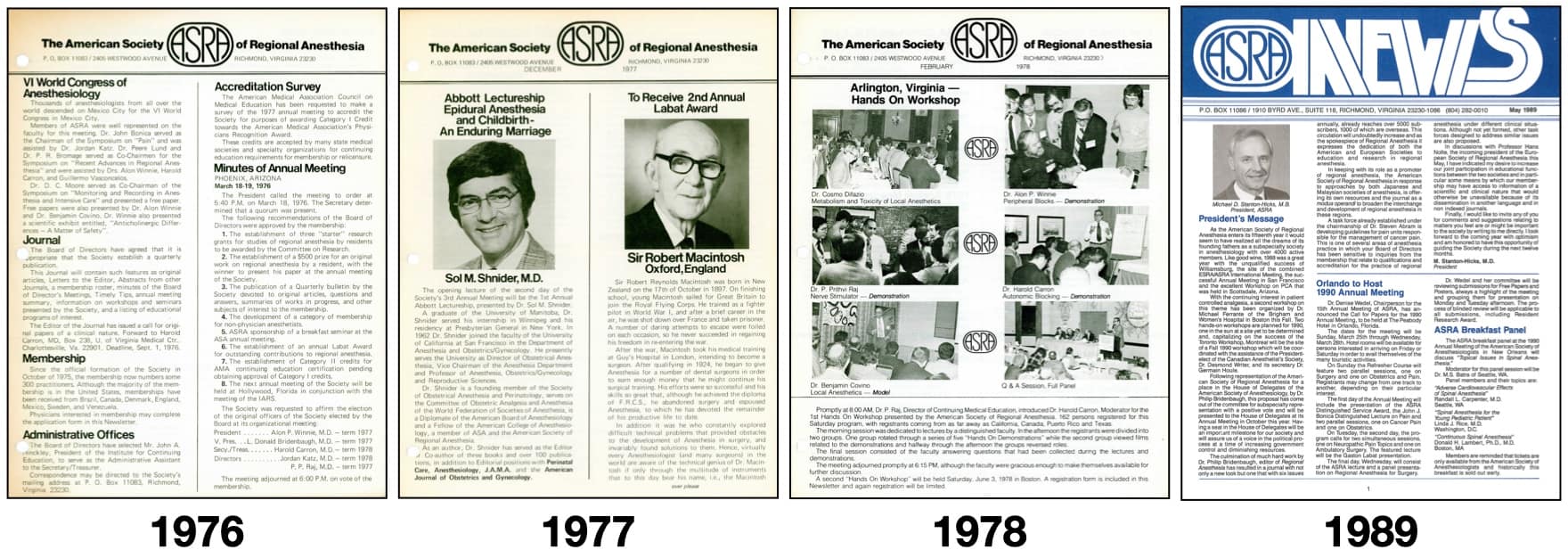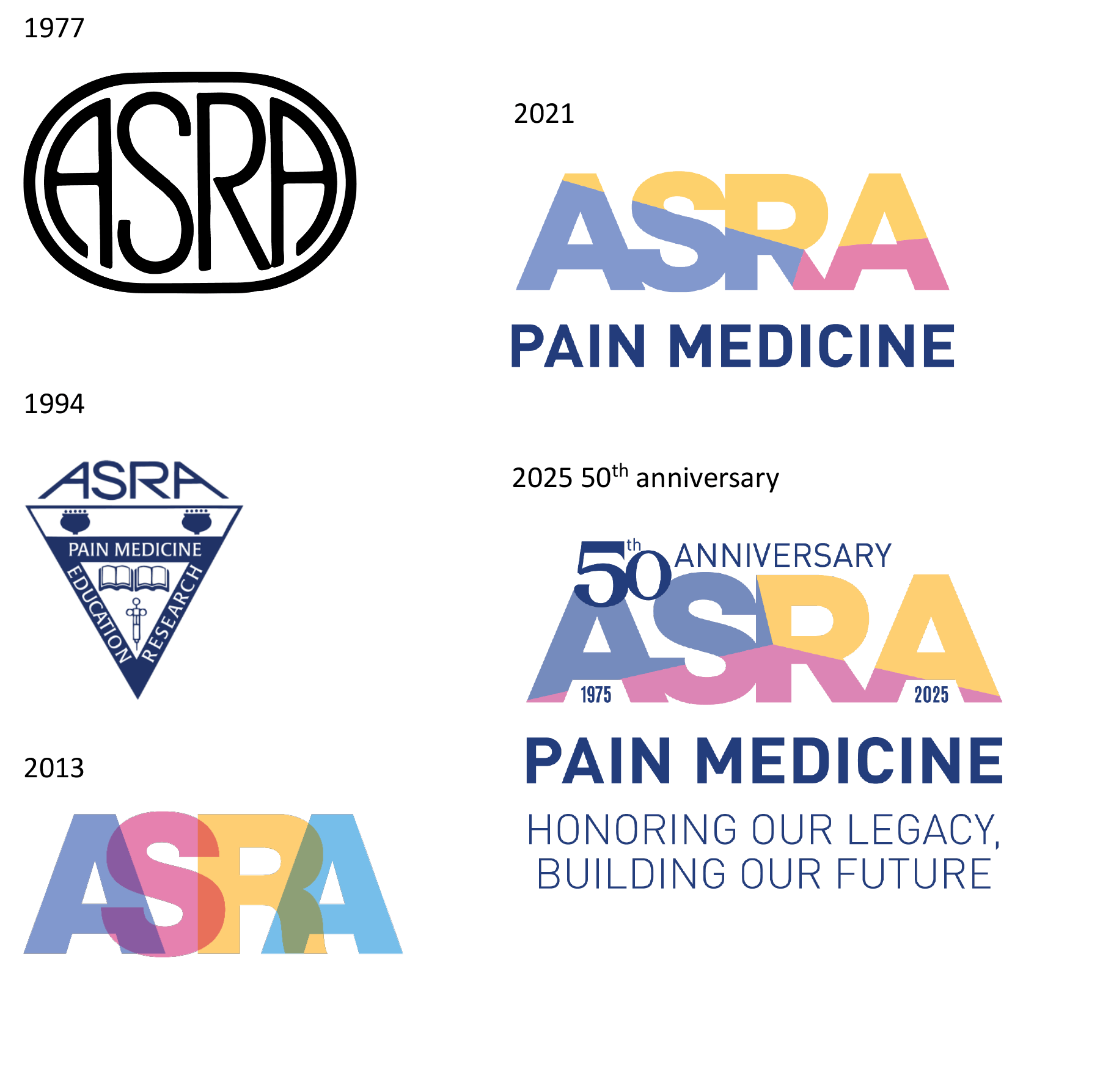The ASRA Pain Medicine Newsletter: Then and Now
Cite as: Ip VHY, Mariano ER, McCartney CJL, et al. The ASRA Pain Medicine Newsletter: then and now. ASRA Pain Medicine News 2025;50. https://doi.org/10.52211/asra050125.004.
The ASRA Pain Medicine Newsletter has been an integral component of the ASRA Pain Medicine communication strategy since 1976. This article will examine the evolution of the newsletter from a publication “devoted to original articles, questions and answers, summaries of works in progress, and other subjects of interest to the membership” to the peer-reviewed, CrossRef-indexed digital publication we know it as today.
After the revival of ASRA Pain Medicine in 1975, the first publication from the society, named Regional Anesthesia, was published in 1976. This was a non-peer-reviewed, industry-sponsored publication, resembling a newsletter or bulletin, and was offered free to members. As shown in Figure 1, the board of directors agreed that the Society should establish a quarterly publication known as the “Journal”: “The Journal will contain such features as original articles, letters to the editor abstracts from other journals, a membership roster, minutes of the Board of Directors’ meetings, timely tips, annual meeting summary, information on workshops and seminars presented by the Society, and a listing of educational programs of interest.” There was a publication committee composed of three members: Harold Carron (chairman), Benjamin Covino, and Alon Winnie. Some publications of ASRA News from earlier years are shown in Figure 1. With time, there was a change in the structure to Regional Anesthesia, which became an indexed, independent, peer-reviewed, scientific journal. In 1998, the name was changed to Regional Anesthesia and Pain Medicine (RAPM), as we know it now. The growth and development of the highly respected RAPM journal also meant that authors with articles that deviated from traditional journal requirements needed an alternative venue for communication to share knowledge, insights, and practice tips and pearls; the perfect platform was and is ASRA Pain Medicine News. (Figures 1A-D) Over the years, there have been many changes and important milestones.

Initially, the publication aimed to enhance professional education and create a sense of community amongst the practitioners within our subspecialty. The focus of ASRA News in the earlier years was neuraxial anesthesia, moving from its use in the obstetrics setting to non-obstetric patients, reflecting the influence of RAPM editor Jerry Ostenheimer, an obstetric anesthesiologist. As the years progressed, the newsletter began to flourish. Two of the most notable change areas were article type and format as single injection and continuous peripheral nerve blocks began to gain momentum. In the late 1990s and early 2000s, co-editors Drs. Kayser Enneking and Terese Horlocker transformed the newsletter from a relatively amorphic compilation of entries to a structured periodical with distinct and identifiable columns, such as “point-counterpoint” discussions. The early 2000s also saw a dramatic expansion in the size of each issue and a move to online availability with the evolution of the internet. During the 2010s, the "How I Do It" subsection became one of the most popular types of articles, serving as a technique library for regional anesthesia and chronic pain procedures. Inspired by its success, new subsections were introduced, such as "Curb Your Enthusiasm," "How We Used to Do It," “Diversity Spotlight,” and "Interviews with Leaders, Members, and Award Winners." As the interests of our readers and the needs of our members evolved, additional sections were developed. These included "COVID-Corner" during the COVID-19 pandemic, "Global Health," "Point-Of-Care UltraSound (POCUS) Spotlight," and "Problem-Based Learning Discussion (PBLD)."
The newsletter has become more responsive and dynamic to keep pace with the rapidly evolving medical landscape. Recently, new subsections such as "ASRA Answers," "AI Frontiers," and "Advocacy in Action" were introduced, reflecting its commitment to promoting inclusion and innovation. Women leaders in regional anesthesia were celebrated through an “interview series” where Trailblazer Award recipients were offered a platform to share their inspiring stories as part of the "Year of Women in ASRA 2020." The newsletter has also published articles to raise awareness about healthcare disparities. Our commitment to fostering an inclusive community continues to grow as we strive to better represent women, racial and ethnic minorities, LGBTQ+ individuals, and other underrepresented groups within the ASRA Pain Medicine community.
The gradual shift of the newsletter from a print version to a digital reader format, and then to an exclusively web-based format during the 2010s, has allowed for further reader engagement. The media types utilized for content have become more versatile, emphasizing the development of graphic and video content. Hyperlinks were embedded into the articles for ease of reference and to enhance direct accessibility to valuable content. These changes coincided with the proliferation of social media in the 2010s, necessitating the creation of the associate editor for social media role. This led to more infographics, which can be more easily shared. During this period, multiple-choice questions accompanying core articles were also developed to entice readers to visit our website to read ASRA News articles.
We also explored leveraging social media for interactive sessions on specific topics. The birth of ASRA Facebook Live specifically for ASRA News content occurred in 2020. The inaugural session presented a discussion of an article on peripheral nerve stimulation. The overall concept was presenting a casual virtual discussion with all the co-authors of the article and giving a broader opportunity for being a presenter, including participation by an anesthesia resident who was one of the co-authors, while making the experience interactive for a public audience. Our current social media efforts continue to evolve as the broader social media landscape forges ahead, which includes sharing the breadth of content across platforms and engaging ASRA Pain Medicine members and broader viewership at points of maximum exposure and utility.
In 2021, ASRA recognized the increasing crossover of acute and chronic pain medicine and underwent a significant rebranding to become ASRA Pain Medicine, where the interconnected contributions of all pain professionals would take centre stage.1 ASRA News became ASRA Pain Medicine News with a new logo (Figure 2) and a refreshed vision. This alignment recognizes that working together is vital to ensure continuity of care for patients. In addition, learning from each other in this community with a wealth of knowledge in regional anesthesia/acute pain and chronic pain tremendously benefits both groups. The commitment to teamwork and cross-disciplinary learning has led to productive partnerships, even outside our society.

Since 2015, significant collaborations have existed between ASRA and ESRA.2-8 However, in the fall of 2023, with the guidance and support of Dr. David Provenzano, international collaboration with our sister societies was initiated and gained momentum after the World Congress of Regional Anesthesia in Paris. All sister societies – European Society of Regional Anesthesia, Latin-American Society of Regional Anesthesia, African Society of Regional Anesthesia, Asian and Oceanic Society of Regional Anesthesia and Pain Medicine and Canadian Anesthesiologists’ Society Regional Anesthesia section – agreed to collaborate and write an article in ASRA Pain Medicine News every year. The goal was to learn from each other, create an inclusive community, and encourage innovation. Together, we created our first truly international PBLD, which was published in August 2024. The piece was a collaborative effort with all six sister societies contributing and gathering broader audience input via a Twitter poll. The sister societies now have representatives (Figure 3) who are part of our newsletter committee and attend our biannual meetings to discuss future projects and opportunities. Inspired by collaborative projects with the Society for Obstetric Anesthesia and Perinatology (SOAP) that led to a consensus statement on pain management for pregnant patients with opioid-use disorder9 and post-dural puncture headache10 we decided to formalize a joint effort with SOAP to encourage the flow of information within our newsletter. In addition, our partnership with Anesthesiology News also promotes our visibility in the field of anesthesia.

With the continuing evolution of the newsletter, the quality of the articles has improved significantly over time. Under the guidance of Dr. Samer Narouze and with the support of Anne Snively, ASRA Pain Medicine’s former communications manager, the articles in ASRA Pain Medicine News became CrossRef-indexed. This significant development made ASRA Pain Medicine News articles more visible and discoverable for broader dissemination through academic search engines and institutional repositories. In addition, indexed newsletter articles can also be easily cited and provide an incentive for contributing to ASRA Pain Medicine News. Therefore, our newsletter committee, both the editorial team and the members-at-large, work tirelessly to ensure quality materials get published to uphold the value and quality of the published works. This effort is reflected in our review process, in which each article is reviewed by at least two members on the executive committee of ASRA Pain Medicine News. The ASRA Pain Medicine support staff also facilitates the smooth running of the quarterly publication. High-quality publications are made possible thanks to the contributions and continual support of subspecialty groups within our ASRA Pain Medicine community, such as the POCUS series initiated by Dr. Hari Kalagara.
As the newsletter content and format have become increasingly complex, the number of members on our committee has also increased with the chair (Figure 4) overseeing the overall functioning and progress of the committee and the editor (also the vice chair) (Figure 5) reviewing all the articles and liaising closely with all the associate editors. The associate editors are divided into regional anesthesia and acute pain (Figure 6) and chronic pain (Figure 7), and the current associate editors, Drs. Kwesi Kwofie (acute pain) and Priyanka Singla (chronic pain) have been invaluable in ensuring that the quality of the articles is upheld and that a consistent succession of articles meaningful to our members are published. Recently, we also had the addition of associate editors for special projects, again divided into the two subspecialties (Figure 8) as well as an associate editor for social media (Figure 8), who liaises with the ASRA Pain Medicine Social Media Committee to increase our presence on social media and promote our branding.





Looking ahead, the newsletter continues to explore innovative ideas and strengthen relationships with the ASRA Pain Medicine Social Media Committee. The change in the medical landscape comes with a greater partnership with the other subspecialties, such as emergency medicine and physiatry, and also means that our focus aspires to be much more inclusive. We hope that the birth of three new series, “ASRA Answers,” “Advocacy in Action,” and “AI Frontiers,” as well as the continual development of the ‘POCUS Spotlight’ and ‘How I Do It’ subsections, can elevate the newsletter to the next level.
In summary, the 50th anniversary of the ASRA Pain Medicine Annual Meeting is an important milestone for us to reflect on our achievements, identify areas for improvement, and share a vision of the future. The development and growth of ASRA Pain Medicine News will continue for years to come. Our commitment to international collaboration and innovation remains strong, ensuring that the newsletter continues to be a valuable resource and a platform to foster communication among medical professionals in the field of regional anesthesia and acute and chronic pain. We thank all our members for their unwavering support and valuable feedback to propel our journey forward.
We would like to thank Drs. Kayser Enneking, Brendan Finucane, Brian Ilfeld, and Joe Neal for their contributions to this article.




References
- Schroeder KM, Sites BD, Narouze S. ASRA Pain Medicine: an established society with an updated vision. Reg Anesth Pain Med 2021;46:1029-30. https://doi.org/10.1136/rapm-2021-103137
- Ivani G, Suresh S, Ecoffey C, et al. The European Society of Regional Anaesthesia and Pain Therapy and the American Society of Regional Anesthesia and Pain Medicine joint committee practice advisory on controversial topics in pediatric regional anesthesia. Reg Anesth Pain Med 2015;40(5):526-32. https://doi.org/10.1097/AAP.0000000000000280
- Lönnqvist PA, Ecoffey C, Bosenberg A, et al. The European Society of Regional Anesthesia and Pain Therapy and the American Society of Regional Anesthesia and Pain Medicine joint committee practice advisory on controversial topics in pediatric regional anesthesia I and II: what do they tell us? Curr Opin Anaesthesiol 2017;30(5):613-20. https://doi.org/10.1097/ACO.0000000000000508
- Suresh S, Ecoffey C, Bosenberg A, et al. The European Society of Regional Anaesthesia and Pain Therapy/American Society of Regional Anesthesia and Pain Medicine recommendations on local anesthetics and adjuvants dosage in pediatric regional anesthesia. Reg Anesth Pain Med 2018;43(2):211-6. https://doi.org/10.1097/AAP.0000000000000702
- Missair A, Cata JP, Votta-Velis G, et al. Impact of perioperative pain management on cancer recurrence: an ASRA/ESRA special article. Reg Anesth Pain Med 2019;44(1):13-28. https://doi.org/10.1136/rapm-2018-000001
- El-Boghdadly K, Wolmarans M, Stengel AD, et al. Standardizing nomenclature in regional anesthesia: an ASRA-ESRA Delphi consensus study of abdominal wall, paraspinal, and chest wall blocks. Reg Anesth Pain Med 2021;46(7):571-80. https://doi.org/10.1136/rapm-2020-102451
- Ecoffey C, Bosenberg A, Lonnqvist PA, et al. Practice advisory on the prevention and management of complications of pediatric regional anesthesia. J Clin Anesth 2022;79:110725. https://doi.org/10.1016/j.jclinane.2022.110725
- El-Boghdadly K, Albrecht E, Wolmarans M, et al. Standardizing nomenclature in regional anesthesia: an ASRA-ESRA Delphi consensus study of upper and lower limb nerve blocks. Reg Anesth Pain Med 2024;49(11):782-92. https://doi.org/10.1136/rapm-2023-104884
- Lim G, Carvalho B, George RB, et al. Consensus statement on pain management for pregnant patients with opioid-use disorder from the Society for Obstetric Anesthesia and Perinatology, Society for Maternal-Fetal Medicine, and American Society of Regional Anesthesia and Pain Medicine. Anesth Analg 2024. https://doi.org/10.1213/ANE.0000000000007237
- Uppal V, Russell R, Sondekoppam RV, et al. Evidence-based clinical practice guidelines on postdural puncture headache: a consensus report from a multisociety international working group. Reg Anesth Pain Med 2024;49(7):471-501. https://doi.org/10.1136/rapm-2023-10481